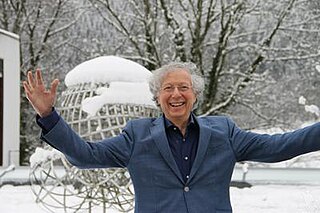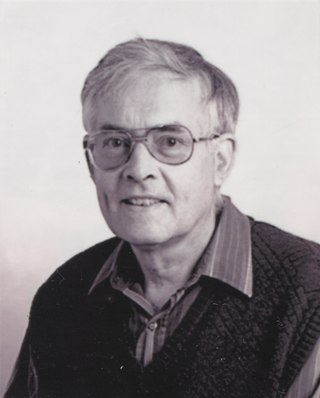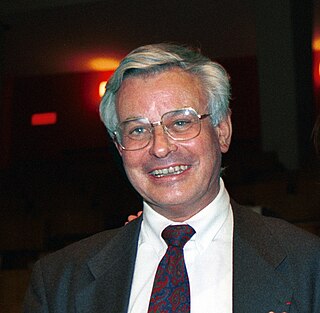
Claudius Gros (born 18 February 1961 in Mainz, Germany) is a German physicist. He is a professor of theoretical physics in Goethe University Frankfurt since 2005. He specializes in computational neurosciences and complex systems theory. [1]

Claudius Gros (born 18 February 1961 in Mainz, Germany) is a German physicist. He is a professor of theoretical physics in Goethe University Frankfurt since 2005. He specializes in computational neurosciences and complex systems theory. [1]
Finishing his studies in physics 1985 at the ETH Zürich with a thesis on heavy Fermions, Gros continued for a PhD in theoretical solid-state physics. Using projected wave functions, as introduced originally by Martin Gutzwiller, he and his advisor, Thomas Maurice Rice, were able to predict d-wave superconductivity for high-temperature superconductors. [2]
From 1988-1990, Gros worked with Steven M. Girvin and Allan H. MacDonald at the Indiana University in Bloomington, Indiana. He then spent time at Dortmund University. In 1999, he joined Saarland University as professor of theoretical physics. In 2005, he moved to Goethe University Frankfurt. Gros now works in complex systems theory, focusing on complex adaptive systems relevant to the neurosciences. His lecture course on the subject has seen four editions. [3] [4] In 2016, Gros published a novel. [5] He is married to physicist Roser Valentí.
In 2016 Gros studied the feasibility of a low-cost interstellar mission, aiming to establish a biosphere of unicellular organisms on otherwise only transiently habitable exoplanets, fast-forwarding evolution potentially by several billion years. [6] The long mission duration would imply, according to Gros, that the Genesis Project would not have any tangible benefit for humanity. The initial acceleration could be achieved by laser propulsion, akin to that envisioned by the Breakthrough Starshot project, with passive deceleration at the target using magnetic sails. Overall, the probe would weight about 1.5 tons and travel at 0.3 percent of the speed of light. [7] An on-board miniaturized gene laboratory would synthesize the microbes. [8]
The precambrian biosphere established by the Genesis probe would evolve subsequently on its own, potentially to complex lifeforms. The concept of the Genesis Project carries a series of fundamental ethical and philosophical aspects, which have been discussed in the media.

The interacting boson model (IBM) is a model in nuclear physics in which nucleons (protons or neutrons) pair up, essentially acting as a single particle with boson properties, with integral spin of either 2 (d-boson) or 0 (s-boson). They correspond to a quintuplet and singlet, i.e. 6 states.
Werner Israel, was a theoretical physicist known for his contributions to gravitational theory, and especially to the understanding of black holes.

Planetary habitability is the measure of a planet's or a natural satellite's potential to develop and maintain environments hospitable to life. Life may be generated directly on a planet or satellite endogenously or be transferred to it from another body, through a hypothetical process known as panspermia. Environments do not need to contain life to be considered habitable nor are accepted habitable zones (HZ) the only areas in which life might arise.
Gian Carlo Wick was an Italian theoretical physicist who made important contributions to quantum field theory. The Wick rotation, Wick contraction, Wick's theorem, and the Wick product are named after him.

Arthur Michael Jaffe is an American mathematical physicist at Harvard University, where in 1985 he succeeded George Mackey as the Landon T. Clay Professor of Mathematics and Theoretical Science.
Amir Ordacgi Caldeira is a Brazilian physicist. He received his bachelor's degree in 1973 from the Pontifícia Universidade Católica do Rio de Janeiro, his M.Sc. degree in 1976 from the same university, and his Ph.D. in 1980 from University of Sussex. His Ph.D. advisor was the Physics Nobel Prize winner Anthony James Leggett. He joined the faculty at Universidade Estadual de Campinas (UNICAMP) in 1980. In 1984 he did post-doctoral work at the Kavli Institute for Theoretical Physics (KITP) at University of California, Santa Barbara and at the Thomas J. Watson Research Laboratory at IBM. In 1994–1995 he spent a sabbatical at the University of Illinois at Urbana-Champaign. He is currently a full professor at Universidade Estadual de Campinas. He was the recipient of the Wataghin Prize, from Universidade Estadual de Campinas, for his contributions to theoretical physics in 1986.
Jerzy Franciszek Plebański was a Polish theoretical physicist best known for his extensive research into general relativity and supergravity.

Johann Rafelski is a German-American theoretical physicist. He is a professor of physics at the University of Arizona in Tucson, guest scientist at CERN (Geneva), and has been LMU-Excellent Guest Professor at the Ludwig Maximilian University of Munich in Germany.

Klaus Hepp is a German-born Swiss theoretical physicist working mainly in quantum field theory. Hepp studied mathematics and physics at Westfälischen Wilhelms-Universität in Münster and at the Eidgenössischen Technischen Hochschule (ETH) in Zurich, where, in 1962, with Res Jost as thesis first advisor and Markus Fierz as thesis second advisor, he received a doctorate for the thesis and at ETH in 1963 attained the rank of Privatdozent. From 1966 until his retirement in 2002 he was professor of theoretical physics there. From 1964 to 1966 he was at the Institute for Advanced Study in Princeton. Hepp was also Loeb Lecturer at Harvard and was at the IHÉS near Paris.
In theoretical physics, the logarithmic Schrödinger equation is one of the nonlinear modifications of Schrödinger's equation, first proposed by Gerald H. Rosen in its relativistic version in 1969. It is a classical wave equation with applications to extensions of quantum mechanics, quantum optics, nuclear physics, transport and diffusion phenomena, open quantum systems and information theory, effective quantum gravity and physical vacuum models and theory of superfluidity and Bose–Einstein condensation. It is an example of an integrable model.
Directed panspermia is a type of panspermia that implies the deliberate transport of microorganisms into space to be used as introduced species on other astronomical objects.
Stephan W. Koch was a German theoretical physicist. He was a professor at the University of Marburg and works on condensed-matter theory, many-body effects, and laser theory. He is best known for his seminal contributions to the optical and electronic properties of semiconductors, semiconductor quantum optics, and semiconductor laser designs. Major portion of his research work has focused on the quantum physics and application potential of semiconductor nanostructures. Besides gaining fundamental insights to the many-body quantum theory, his work has provided new possibilities to develop, e.g., laser technology, based on accurate computer simulations. His objective has been to self-consistently include all relevant many-body effects in order to eliminate phenomenological approximations that compromise predictability of effects and quantum-device designs.
Ryan Milton Rohm is an American string theorist. He is one of four physicists known as the Princeton string quartet, and is responsible for the development of heterotic string theory along with David Gross, Jeffrey A. Harvey and Emil Martinec, the other members of the Princeton String Quartet.
Walter Greiner was a German theoretical physicist and professor of the Goethe University Frankfurt. His research interests lay in atomic physics, heavy ion physics, nuclear physics, elementary particle physics. He is known for his series of books in theoretical physics, particularly in Germany but also around the world.

Breakthrough Starshot is a research and engineering project by the Breakthrough Initiatives to develop a proof-of-concept fleet of light sail interstellar probes named Starchip, to be capable of making the journey to the Alpha Centauri star system 4.34 light-years away. It was founded in 2016 by Yuri Milner, Stephen Hawking, and Mark Zuckerberg.

Luciano Rezzolla is an Italian professor of relativistic astrophysics and numerical relativity at the Goethe University Frankfurt. His main field of study is the physics and astrophysics of compact objects such as black holes and neutron stars. It was announced in 2019 that he had been appointed honorary Andrews Professor of Astronomy at Trinity College Dublin (TCD).

Maurice René Michel Jacob was a French theoretical particle physicist.

Wulfram Gerstner is a German and Swiss computational neuroscientist. His research focuses on neural spiking patterns in neural networks, and their connection to learning, spatial representation and navigation. Since 2006 Gerstner has been a full professor of Computer Science and Life Sciences at École Polytechnique Fédérale de Lausanne (EPFL), where he also serves as a Director of the Laboratory of Computational Neuroscience.

Tensor networks or tensor network states are a class of variational wave functions used in the study of many-body quantum systems and fluids. Tensor networks extend one-dimensional matrix product states to higher dimensions while preserving some of their useful mathematical properties.
Alain Rouet is a French theoretical physicist, entrepreneur, poet, and novelist.